The environmental impacts from the most common electricity production technologies are summarized in table 1. From table 1 it is obvious that the environmental and human impacts of wind parks are significantly less important compared to the respective impacts of conventional electricity production technologies (thermal or nuclear power plants).
|
Table 1: Environmental impacts from the most common production technologies of electricity. |
|||
|
Energy source |
Production technology |
Gas emissions |
Other environmental impacts |
|
Coal, oil, |
Thermal power plants |
CO2, NOx, SOx, VOC, ash |
Exhaustion of reserves, pollution during transportation. |
|
Nuclear fuel |
Nuclear power reactors |
- |
Nuclear waste, nuclear weapons, nuclear accidents. |
|
Biomass |
Thermal power plants |
CO2, SOx, VOC, cinder |
Reduction of agricultural production. |
|
Hydro power |
Hydroelectric power plants |
- |
Impact on sensitive biotopes, dangers from the collapse of dams. |
|
Wind energy |
Wind parks |
- |
Visual impact, noise emission, impacts on birds, shadow flicker, land use, electromagnetic interference. |
|
Solar radiation |
Photovoltaic parks |
- |
Land use, visual impact. |
Despite the abovementioned facts, under certain circumstances, the environmental and human impacts of a wind park can be important for the neighbouring area of its installation site. On this occasion, significant negative public reactions may appear during the wind park’s licensing, installation or operation [1-4]. Such reactions can only be treated beforehand with the appropriate selection of the wind park’s installation site, as well as with carefully planned dissemination policies [5-7].
The present article investigates environmental and human impacts of wind parks. The article aims to evaluate the impacts of wind parks and to investigate the prerequisites for a wind park’s mild and secure operation. This aim is approached with the following tasks:
At a first stage, a review of the impacts of wind parks, based on extensive research on the most recent relevant bibliography is fulfilled. With this task, the global experience on the environmental and human impacts of wind parks, as provided by different teams of scientists (engineers, biologists, environmentalists), is gathered.
At a second stage, a case study is fulfilled for the Prefecture of Lasithi, in Crete. This study includes visual impacts evaluation and noise emissions calculation for selected wind parks installed in the Prefecture of Lasithi. The case study is integrated with a statistical survey implemented in Crete about the public opinion concerning wind parks and wind energy.
Finally, following the results of both the former relevant articles and the implemented case study in Crete, a map with the optimum sites for wind parks installation in the Prefecture of Lasithi is constructed, taking into account all possible restrictions concerning the use of land, the impact on human life and the environmental conservation. This map can constitute a flexible decision tool for the optimum site selection for a wind park installation, contributing both to the limitation of the environmental and human impacts of the new wind parks, to the minimization of the required project’s licensing time and to the elimination of possible negative public reactions.
1. Visual impact
Visual impact of wind parks is based on the influence on a landscape’s view, caused by the installation of huge technical constructions, especially in sites with a lack of any other human interference. The required network for the produced electricity transportation affects the landscape as well.
The wind turbines’ size, in combination with their installation positions (usually at the top of hills or mountains) make them visible even from great distances. Consequently, the influence of wind parks on the landscape is indubitable. The question is whether this influence can be accepted or not. The answer is rather subjective, since it depends on the point of view with which one may face this issue [8]. Sometimes wind turbines may be considered as large and ugly constructions that convert natural landscapes to industrial areas, sometimes as useful and clever machines that produce clean and cheap energy and sometimes as one of the most promising solutions towards the limitation of the operation of the thermal and nuclear power plants, a fact that makes them invaluable and irreplaceable.
The evaluation of the visual impact of a wind park in a landscape is a difficult multi-parametric task [9-13]. Despite the subjective nature of this issue, there are some objective parameters that affect the visual acceptability of a wind park [14]. Generally, these parameters are:
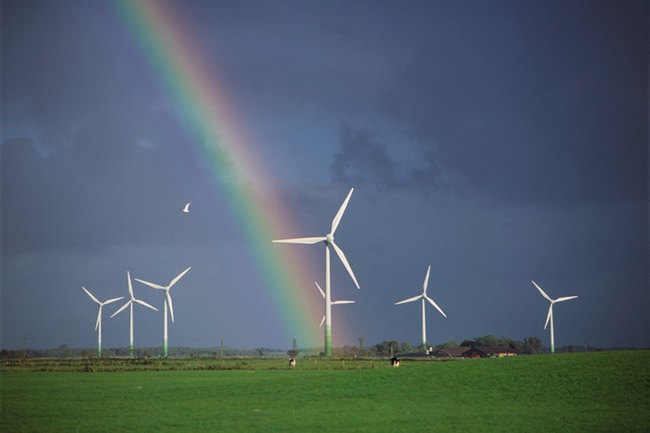
Figure 1: Wind turbines pylons colored according to the surrounding environment.
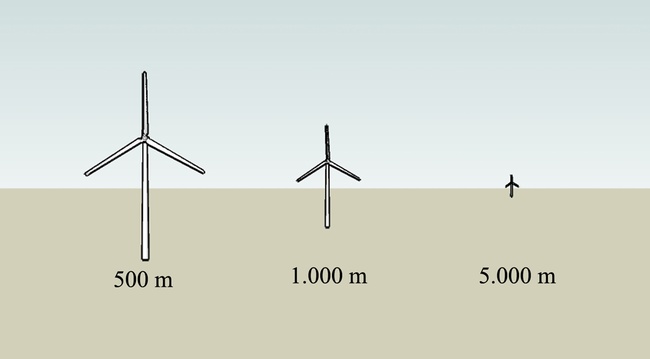
Figure 2: The visual impact of a wind turbine versus the distance from its installation site.
2. Noise emission
The wind turbines’ operational noise is not intensive just a few hundred meters away from its source and it is usually masked by the noises produced by the wind itself. Moreover, areas where strong winds blow, namely areas appropriate for wind parks installations, are not usually chosen for the development of human activities (residential or industrial areas).
The noise produced from a wind turbine is divided into the aerodynamic and mechanical noise.
The aerodynamic noise emissions depend on the blade’s aerodynamic design and the wind velocity. The aerodynamic noise is treated during the design of the turbine’s rotor. It consists of the rotation noise and the turbulence noise [15].
The rotation noise includes noises with frequencies harmonics of the rotor’s rotation frequency. The rotation noise emissions level increases with the rotor’s diameter, the reduction of the blades’ number, the blades’ angular velocity and the blades’ aerodynamic load (increase of the captured wind energy).
The turbulence noise is produced by the vortex at the edge (tip) of the blades and the turbulence behind the rotor. The turbulence noise reduces with the reduction of the blades’ angular velocity, namely with the reduction of the produced power.
During the last two decades extensive research has been carried out in the field of aerodynamic design of the wind turbine’s blades, with main targets the increase of the produced power, the reduction of the blades’ mechanical loads and the reduction of the aerodynamic noise emissions. As a result, the aerodynamic noise emissions from the modern wind turbines are less than 10% of the respective emissions from the wind turbines of the early eighties.
The wind turbines mechanical noise is caused by the moving electromechanical parts of the machine. The main sources of the mechanical noise are the machine’s gear box, the electrical generator and the main shaft’s bearings. The mechanical noise is treated either on its sources or during its diffusion with appropriate insulation techniques.
The noise emissions level from modern wind turbines ranges between 95 – 105 dB and mainly consists of the aerodynamic noise. The mechanical noise is remarkably reduced, with either the introduction of several noise insulation techniques, or the elimination of the machine’s gear box. The mechanical noise in modern wind turbines may be detectable only in case of a machine fault. The aerodynamic noise is continuously reduced by the constructors, by improving the blades’ aerodynamic design.
Several methods have been developed for the wind parks’ noise diffusion calculation [16-18]. An accurate noise emission calculation may require special calculations for night time [19]. Typical noise diffusion in terms of distance from a modern wind turbine is presented in table 2.
|
Table 2: Wind turbine’s emitted noise diffusion. |
|||
|
Emitted noise level from the wind turbine (dB) |
Distance for noise level reduction at 45 dB |
Distance for noise level reduction at 40 dB |
Distance for noise level reduction at 35 dB |
|
105 |
350 m |
575 m |
775 m |
|
100 |
200 m |
350 m |
575 m |
|
95 |
120 m |
200 m |
350 m |
The noise emissions level from several human activities or devices is presented in table 3.
|
Table 3: Noise level emitted by several human activities or devices. |
|
|
Human activity or device |
Emitted noise level (dB) |
|
Human speech |
65 |
|
Elecrtrical refrigerator |
35 – 40 |
|
City centre |
75 |
|
Night club |
100 |
|
Bedroom during siesta |
30 |
The upper limit for the wind turbines’ noise emissions level in residential areas varies in different countries in the European Union. This limit is set in 45 dB in Denmark and in 40 dB in Greece and Sweden. In Great Britain this limit is allowed to be 5 dB higher than the average noise level in an area.
The wind turbines noise may be detectable only under certain conditions. In low wind velocities wind turbines do not operate, hence they do not produce noise. In wind velocities higher than 8 m/sec the wind turbines noise emissions are covered by the several noises produced by the wind (tree leaves, etc). The wind turbines’ noise may be detectable only when the wind velocity ranges between 3 and 8 m/sec. Even in this case, the noise diffusion is significant only in the direction in which the wind is blowing. A major factor that may affect the noise annoyance of people living close to a wind park is the visual contact with the source of noise [20].
3. Impacts on birds and wildlife
Fatalities of birds and bats caused by wind turbines were firstly recorded in the late eighties in the U.S.A. Specifically, it was observed that specially protected endemic bird species (golden eagles, hawks) were killed either by wind turbines or by high voltage utility network lines, in California’s Altamont Pass (figure 3). These facts directed the scientists’ interest towards the study of this problem.
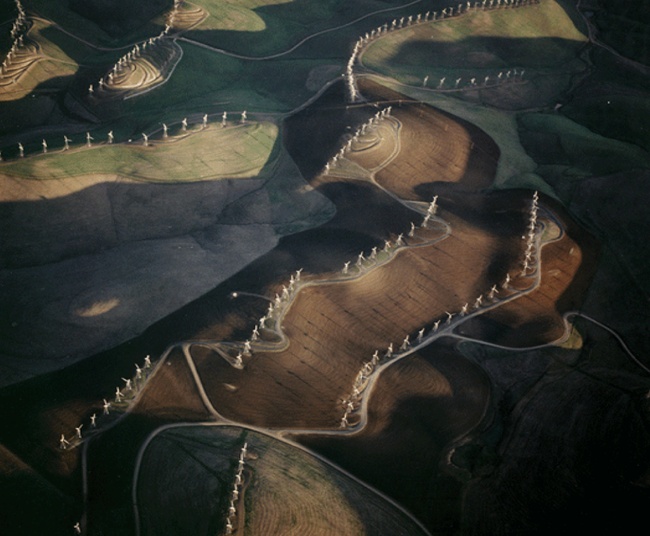
Figure 3: Aerial photo of the wind park in Altamont, California.
Generally, wind turbines affect birds in one of the following ways [21-24]:
There is a strong connection between an area and its birds’ fauna. Birds usually depend heavy on their biotope and they are extremely sensitive to possible modifications that take place in it. On the other hand, there is a strong connection between an area and the optimum siting of a wind park, imposed mainly by the available wind potential and the land morphology of the installation site. A conflict between the optimum siting of a wind park and the conservation of a sensitive biotope is often met.
There are a considerable number of studies on the impacts of wind parks on birds. Generally, wind turbines, under specific conditions, can constitute a serious danger for birds. It is proved that areas with strong air streams are used as passages by birds, especially migratory ones. The installation of wind turbines in such areas creates a potential collision risk with birds [25]. Wind turbines installed in the vicinity of endangered species’ biotopes can also constitute a serious threat [26-28].
On the other hand, several studies conclude that wind turbines do not constitute a serious threat for birds, mainly because birds, in general, have the ability to detect wind turbines in time and change their flying path early enough to avoid them [29-33]. Another argument is that wind parks affects birds significantly less than several other human activities [34].
Both categories of former studies conclude that, in order to eliminate the probability of harming the natural environment significantly, and especially birds, a wind park should be designed properly and all the possible impacts on birds should be examined with scrutiny beforehand [35-37]. The implementation of systematic pre- and post-construction studies to explore the potential impacts of wind parks on wildlife can contribute to the optimisation of the wind park siting, taking into account both the maximisation of the produced electricity and the conservation of wildlife. If necessary, special measures for the protection of birds must be introduced during the wind park’s operation [25]. A general collaboration between the wind parks developers, the state and their agencies responsible for the wildlife can also contribute to the proper selection of wind parks installation areas.
For a better estimation of impact of wind parks on birds, the implementation of longer-term studies with extensive follow-up, based on systematically collected data according to standardized protocols is also suggested [24].
Further adverse effects on wildlife, except birds, can also be caused by wind parks. The infrastructure works required for the installation of a wind park alter ecosystems through the clearing of vegetation, soil disruption and the potential for erosion. These changes can be of major importance and lead even to habitat loss and fragmentation for forest-dependent species in case of a wind park planned to be installed in a forested area [33]. On such occasions, changes in forested ecosystems may considerably affect its flora and fauna, although no deaths of animals may be directly caused by the wind park.
4. Shadow flicker from wind turbines
Settlements nearby to wind parks may suffer from the wind turbines’ shadow flicker for certain time periods during a year. The turbines’ blades cast a shadow on the neighbouring area when the sun is visible. When the turbine’s blades are rotating, they cast moving shadows across the landscape and houses. At a constant point this is experienced as a flickering as the blades pass in front of the sun, causing an undesirable or even disturbing feeling [38-41].
The possibility for suffering from a wind turbine’s shadow flicker is much higher for wind parks installed close to residential areas. According to the Hellenic legislation, the minimum distance between a wind park and a settlement is 500 m. This distance restricts the possibility for a settlement to suffer from a turbine’s shadow flicker. The shadow of a turbine’s blade fades through the atmosphere and it is practically invisible after a specific distance. Theoretically, the shadow of a 22 m long turbine blade may be visible up to a distance of 4.8 km. This may occur just a little after the sunrise and just a little before the sunset. Practically, for a 3 MW wind turbine, with a blade of 45 m length and 2 m width, the shadow of the spinning blade may be visible up to a distance of 1.4 km, although some weak shadow casting may be observed at a distance of 2 km [38-41].
Another major parameter, except distance, is the flicker frequency. Flicker frequency is the critical factor for serious human diseases [41] and should be kept to a maximum of three blade’s passes per second, namely sixty revolutions per minute for a three-bladed turbine. Additionally, turbine blades should not be reflective.
From sunset to sunrise, the shadow of a wind turbine follows the route of a sundial, beginning from west and ending to the east. Since the positions of sunrise and sunset change during the year, the daily route of a wind turbine’s shadow is not the same for different time periods during a year. Consequently, it is obvious that a specific point on earth will suffer from a wind turbine’s shadow flicker for only a very specific time period at a very specific moment during the year. Moreover, taking into account that the sunrise and sunset positions at a certain region on earth are known during a year, the moment and the period during which a specific point on earth will suffer from a wind turbine’s shadow flicker may be predicted [40]. Computer models in wind development software can determine the days and times during the year that specific buildings in close proximity to turbines may experience shadow flicker.
It is obvious that you can not avoid shadow flicker after the construction of a wind farm, unless you prevent wind turbines’ rotors from rotating. Shadow flicker from wind turbines can be predicted and avoided only with the appropriate design of the siting of a wind farm. The abovementioned software tools can contribute towards this direction. The positions of the nearby habited settlements should be taken into account and the minimum distances from them, as defined in the national legislative frameworks, should be kept.
5. Use of land
A very common argument is that wind parks require more land than the conventional power plants (thermal and nuclear) to produce the same quantity of power, namely they exhibit lower power density. However, after a more thorough analysis, it is revealed that the above thesis is not indubitable. Both the thermal and the nuclear power plants require significant amount of land for several procedures that take place before, during and after the power production. These procedures may be the mining or the pumping of the fuel, the fuel’s transportation, the fuel’s preparation process and storage, the storage or the disposal of the production waste, etc. For the above procedures mines, oil refineries, ports, storage premises and power plant stations are all used. Except for the abovementioned places, large amounts of land in proximity to the thermal or nuclear power stations are strongly affected by their operation and, often, they become uninhabitable for humans or animals.
According to former studies, approximately 200 – 5,000 m2 of land per MW of installed wind power are required [42]. If wind turbines with nominal power higher than 2 MW are used, the above figures are lower. Practically, the land occupied by a 3 MW wind turbine is a square around the turbine of 40 m x 40 m = 1,600 m2. Only inside this area no activities may be fulfilled. Except for this specific area, the remaining land of a wind park may be used for other activities too (figures 4 – 6).
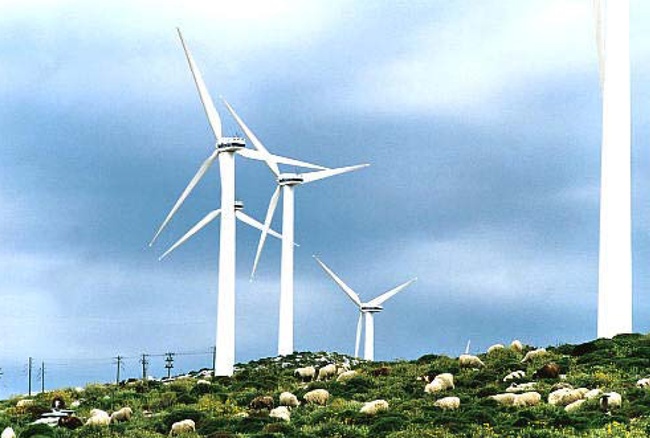
Figure 4: Sheep grazing inside a wind park’s land in the mountainous Crete.
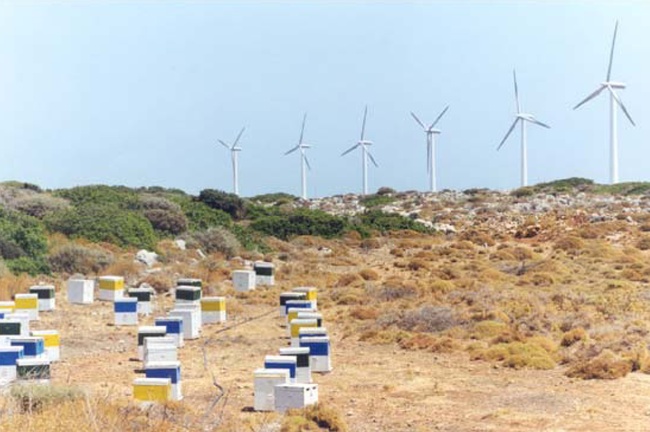
Figure 5: Beehives next to a wind park in the mountainous Crete.
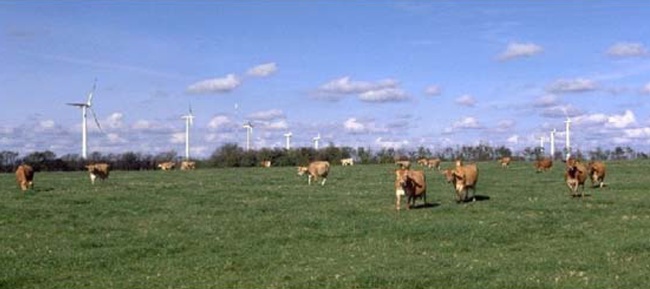
Figure 6: Cows grazing next to a wind park in the western Europe.
Table 4 summarizes the land occupation for power production using different conventional or renewable technologies [43]. The land occupation, as presented in table 4 involves the duration over which the area of the transformed land returns to its original state (reclamation period), measured as a product of land area (m2) and time (year).
|
Table 4: Land occupation for electricity production from different technologies. |
|||||||
|
|
Biomass |
Nuclear |
Coal |
Natural gas |
Hydro |
PV |
Wind |
|
Land occupation (m2.years/GWh of produced electricity) |
380,000 |
300,000 |
1,290 – 25,200 |
4,200 |
2,350 – 25,000 |
9,900 |
2,040 |
As shown in table 4, biomass farming (willow, high-pressure gasification) entails the greatest land occupation, 380,000 m2 year/GWh, followed by nuclear-fuel disposal, 300,000 m2 year/GWh (=30 m2/GWh x 10,000 years of reclamation). The land occupation of surface coal mining varies between 1,290 m2 year/GWh (43 m2/GWh x 30 years of reclamation), and 25,200 m2 year/GWh (840 m2/GWh x 30 years of reclamation). The land use for a natural-gas power plant is estimated 4,200 m2 year/GWh (140 m2/GWh x 30 years of reclamation). A PV power plant with 13% efficient modules requires 9,900 m2 year/GWh of land occupation. A wind park with a capacity factor of 36% requires 2,040 m2 year/GWh of land occupation. Finally, the land required for generating hydroelectric power varies significantly according to site-specific conditions (from 2,350 – 25,000 m2 year/GWh).
6. Electromagnetic interference
Problems related to wind turbines’ electromagnetic interference are caused by [44]:
The transmission from radio or television broadcast frequencies (mainly FM broadcast frequencies) is influenced by obstacles between the transmitter and the receiver. The main problem created by wind turbines is caused by the moving blades which can result in signal variations due to deflection. This effect was more of a problem with first generation wind turbines which had metal blades. The blades of modern wind turbines are now made exclusively of synthetic materials which have a minimal impact on the transmission of electromagnetic radiation [44-46].
According to the Hellenic legislation, a license for a wind park will only be granted if some minimum distances are kept from telecommunications or radio and television stations. Problems related to wind turbines’ electromagnetic interference can be prevented by proper design and location of wind parks. The installation of additional transmitter masts, if required, can also be a solution, with low additional cost for the wind park investors [44-48].
As far as the wind turbines’ electromagnetic emissions are concerned, the only subsystems of a wind turbine which could possibly “emit” low level electromagnetic radiation are the electric generator and the medium voltage transformer. The electromagnetic field of a wind turbine is extremely weak and is confined to a very short distance from the exterior turbine housing which is at least 40-50 metres above the ground [44, 47, 48]. Consequently, there is no exposure to electromagnetic radiation at all, and especially not at the base of the wind turbine.
7. References
[1] F. Lubbers. Research program concerning the social and environmental aspects related to the windfarm project of SEP. Journal of Wind Engineering and Industrial Aerodynamics 1988; 27: 439-453.
[2] Gonzalo Gamboa, Giuseppe Munda. The problem of wind farm location: A social multi-criteria evaluation framework. Energy Policy 2007; 35: 1564-1583.
[3] Maria Johansson, Thorbjörn Laike. Intention to respond to local wind turbines: the role of attitudes and visual perception. Wind Energy 2007; 10: 435-451.
[4] J. K. Kaldellis. Social attitude towards wind energy applications in Greece.
Energy Policy 2005; 33: 595-602.
[5] Maarten Wolsink. Wind power implementation: The nature of public attitudes: Equity and fairness instead of ‘backyard motives’. Renewable and Sustainable Energy Reviews 2007; 11: 1188-1207.
[6] Patrick Devine-Wright. Beyond NIMBYism: towards an integrated framework for understanding public perceptions of wind energy. Wind Energy 2005; 8: 125-139.
[7] Begoña Álvarez-Farizo, Nick Hanley. Using conjoint analysis to quantify public preferences over the environmental impacts of wind farms. An example from Spain. Energy Policy 2002; 30: 107-116.
[8] Robert L. Thayer, Carla M. Freeman. Altamont: Public perceptions of a wind energy landscape. Landscape and Urban Planning 1987; 14: 379-398.
[9] Ana del Carmen Torres Sibille, Víctor-Andrés Cloquell-Ballester, Vicente-Agustín Cloquell-Ballester, Richard Darton. Development and validation of a multicriteria indicator for the assessment of objective aesthetic impact of wind farms. Renewable and Sustainable Energy Reviews 2007; In Press. Available online 14 August 2007.
[10] Juan Pablo Hurtado, Joaquín Fernández, Jorge L. Parrondo, Eduardo Blanco. Spanish method of visual impact evaluation in wind farms. Renewable and Sustainable Energy Reviews 2004; 8: 483-491.
[11] J. Jallouli, G. Moreau. An immersive path-based study of wind turbines’ landscape: A French case in Plouguin. Renewable Energy; In Press. Available online 16 July 2008.
[12] Jacob Ladenburg. Visual impact assessment of offshore wind farms and prior experience. Applied Energy 2008; In Press. Available online 27 June 2008.
[13] Andrew Lothian. Scenic Perceptions of the Visual Effects of Wind Farms on South Australian Landscapes. Geographical Research 2008; 46: 196-207.
[14] Ian D. Bishop, David R. Miller. Visual assessment of off-shore wind turbines: The influence of distance, contrast, movement and social variables. Renewable Energy 2007; 32: 814-831.
[15] S. Oerlemans, P. Sijtsma, B. Méndez López. Location and quantification of noise sources on a wind turbine. Journal of Sound and Vibration 2007; 299: 869-883.
[16] Martin Björkman. Long time measurements of noise from wind turbines.
Journal of Sound and Vibration 2004; 277: 567-572.
[17] John M. Prospathopoulos, Spyros G. Voutsinas. Application of a ray theory model to the prediction of noise emissions from isolated wind turbines and wind parks. Wind Energy 2007; 10: 103-119.
[18] A.E. Filios, N.S. Tachos, A.P. Fragias, D.P. Margaris. Broadband noise radiation analysis for an HAWT rotor. Renewable Energy 2007; 32: 1497-1510.
[19] G. P. van den Berg. Effects of the wind profile at night on wind turbine sound.
Journal of Sound and Vibration 2004; 277: 955-970.
[20] Eja Pedersen, Pernilla Larsman. The impact of visual factors on noise annoyance among people living in the vicinity of wind turbines. Journal of Environmental Psychology 2008; In Press. Available online 29 February 2008.
[21] Allan L. Drewitt, Rowena H. W. Langston. Assessing the impacts of wind farms on birds. Ibis 2006; 148: 29-42.
[22] Mike Madders, D. Philip Whitfield. Upland raptors and the assessment of wind farm impacts. Ibis 2006; 148: 43-56.
[23] Ruiz, C., S. Schindler and K. Poirazidis. 2005. Impact of wind farms on birds in Thrace, Greece. Technical Report, 2005. WWF Greece, Athens.
[24] The Wildlife Society. Impacts if Wind Energy Facilities on Wildlife and Wildlife Habitat. 2007. http://joomla.wildlife.org/documents/positionstatements/Draft_Wind_Energy.pdf.
[25] Ommo Hüppop, Jochen Dierschke, Klaus-Michael Exo, Elvira Fredrich, Reinhold Hill. Bird migration studies and potential collision risk with offshore wind turbines. Ibis 2006; 148: 90-109.
[26] Ryunosuke Kikuchi. Adverse impacts of wind power generation on collision behaviour of birds and anti-predator behaviour of squirrels. Journal for Nature Conservation 2008; 16: 44-55.
[27] Erin F. Baerwald, Genevieve H. D’Amours, Brandon J. Klug, Robert M.R. Barclay. Barotrauma is a significant cause of bat fatalities at wind turbines. Current Biology 2008; 18: R695-R696.
[28] Michael L. Morrison, Karin Sinclair. Wind Energy Technology, Environmental Impacts of, In: Cutler J. Cleveland, Editor(s)-in-Chief, Encyclopedia of Energy, Elsevier, New York, 2004, Pages 435-448, ISBN 978-0-12-176480-7, 10.1016/B0-12-176480-X/00419-8. (http://www.sciencedirect.com/science/article/B7GGD-4CM9GC0-F8/2/c703759ee8701f421195e89fba7d5134)
[29] Jesper K. Larsen, Magella Guillemette. Effects of wind turbines on flight behaviour of wintering common eiders: implications for habitat use and collision risk. Journal of Applied Ecology 2007; 44: 516-522.
[30] Luis Barrios, Alejandro Rodrνguez. Behavioural and environmental correlates of soaring-bird mortality at on-shore wind turbines. Journal of Applied Ecology 2004; 41: 72-81.
[31] Mark Desholm, Johnny Kahlert. Avian collision risk at an offshore wind farm. Biology letters 2005; 1: 296-298.
[32] Manuela de Lucas, Guyonne F.E. Janss, Miguel Ferrer. The effects of a wind farm on birds in a migration point: the Strait of Gibraltar. Biodiversity and Conservation 2004; 13: 395-407.
[33] Alan H. Fielding, D. Philip Whitfield, David R.A. McLeod. Spatial association as an indicator of the potential for future interactions between wind energy developments and golden eagles Aquila chrysaetos in Scotland. Biological Conservation 2006; 131: 359-369.
[34] The National Research Council. Environmental Impact of Wind Energy Projects. 2007. http://dels.nas.edu/dels/rpt_briefs/wind_energy_final.pdf.
[35] M. Desholm, A. D. Fox, P. D. L. Beasley, J. Kahlert. Remote techniques for counting and estimating the number of bird-wind turbine collisions at sea: a review. Ibis 2006; 148: 76-89.
[36] Stefan Garthe, Ommo Hüppop. Scaling possible adverse effects of marine wind farms on seabirds: developing and applying a vulnerability index. Journal of Applied Ecology 2004; 41: 724-734.
[37] Jenny Bright, Rowena Langston, Rhys Bullman, Richard Evans, Sam Gardner, James Pearce-Higgins. Map of bird sensitivities to wind farms in Scotland: A tool to aid planning and conservation. Biological Conservation 2008; In Press. Available online 28 August 2008.
[38] American Wind Energy Association. Wind Turbines and Health. 3-2009. http://www.awea.org/pubs/factsheets/Wind_Turbines_and_Health.pdf.
[39] David E. Kabes & Crystal Smith. Lincoln Township Wind Turbine Survey. Agricultural Resource Center, University of Wisconsin Extension/Cooperative Extension. May 16, 2001.
[40] http://www.windpower.org/en/tour/env/shadow/index.htm.
[41] Graham Harding, Pamela Harding, Arnold Wilkins. Wind turbines, flicker, and photosensitive epilepsy: Characterizing the flashing that may precipitate seizures and optimizing guidelines to prevent them. Epilepsia 2008; 49: 1095-1098.
[42] Bernd Möller. Changing wind-power landscapes: regional assessment of visual impact on land use and population in Northern Jutland, Denmark. Applied Energy 2006; 83: 477-494.
[43] Vasilis Fthenakis, Hyung Chul Kim. Land use and electricity generation: A life-cycle analysis. Renewable and Sustainable Energy Reviews 2009; 13: 1465-1474.
[44] E. Binopoulos, P. Haviaropoulos. Environmental Impacts of Wind Farms: Myth and Reality. Centre for Renewable Energy Sources (CRES). 1-2006. http://www.cres.gr/kape/publications/papers/dimosieyseis/CRESTRANSWINDENVIRONMENT.doc.
[45] Whitney Wilson. Interference of Wind Turbines with Wide Area Communications. Black & Veatch. 6-2006. http://www.masstech.org/Project%20Deliverables/Comm_Wind/Eastham/Eastham_Cell_Tower_Analysis.pdf.
[46] Alex Steele. An environmental impact assessment of the proposal to build a wind farm at Langdon Common in the North Pennines, UK. The Environmentalist 2005; 11: 195-212.
[47] Steven Buckley. Wind farms & Electromagnetic Interference – Dispelling the Myths. Sinclair Knight Merz. 5-2005. http://www.skmconsulting.com/Markets/energy/Wind_farms_Electromagnetic_Interference.htm.
[48] Sengupta, D.L. Electromagnetic interference from wind turbines. IEEE Antennas and Propagation Society International Symposium, 1999. Orlando, FL, USA. 07/11/1999 - 07/16/1999. 3: 1984-1986.